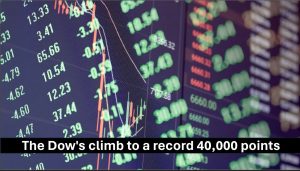The Dow’s climb to a record 40,000 points

The Dow Jones Industrial Average, a laggard among the major U.S. stock indexes this year, got its moment in the spotlight on Thursday as it briefly broke above 40,000 points for the first time in its history.
The record on the Dow – as well as fresh records on the S&P 500 and Nasdaq Composite earlier this week – come as investors grow more confident that the U.S. is heading for an economic soft landing, where the Federal Reserve is able to tame inflation without badly hurting growth.
A stronger-than-expected earnings season has also helped propel stocks higher, with 77% of companies beating estimates, compared to 67% historically, according to LSEG IBES data as of May 10.
While Dow components are weighted in the index by their share prices, S&P 500 stocks are weighted largely by their market value. The relatively infrequent changes to the Dow means it sometimes may be slower to include some of the hottest companies.
Some $89 billion in assets is benchmarked to the Dow, compared to $11.45 trillion pegged to the S&P 500, according to the S&P Dow Jones Indices annual survey of assets as of December 2023.
Still, the price-weighted index retains cultural cache: established in 1896, it is far older than the S&P 500, which was launched in 1957 and the Nasdaq, which was launched in 1971. The Dow outperformed the S&P 500 in eight of the last 20 years. This year, it is up 5.8%, compared to the S&P 500’s 11.1% year-to-date gain and the Nasdaq’s 11.2% rise.
Important Note: The information found on Ausprime platform is intended only to be informative, is not advice nor a recommendation, nor research, or a record of our trading prices, or an offer of, or solicitation for a transaction in any financial instrument and thus should not be treated as such. The information provided does not include any specific investment objectives, financial situation and needs of any specific person who may receive it. The past performance is not a reliable indicator of future performance and/or results. Past Performance or Forward-looking scenarios are not a guarantee of future performance. Actual results may differ materially from those anticipated in forward-looking or past performance statement